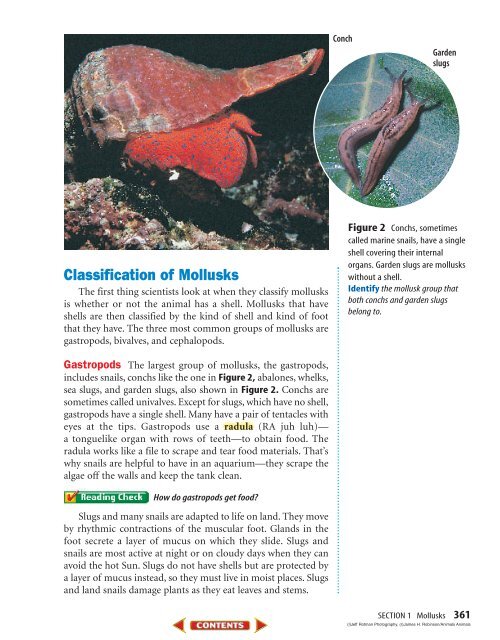Chapter 13: Mollusks, Worms, Arthropods, Echinoderms
Chapter 13: Mollusks, Worms, Arthropods, Echinoderms
Chapter 13: Mollusks, Worms, Arthropods, Echinoderms
Create successful ePaper yourself
Turn your PDF publications into a flip-book with our unique Google optimized e-Paper software.
Classification of <strong>Mollusks</strong><br />
The first thing scientists look at when they classify mollusks<br />
is whether or not the animal has a shell. <strong>Mollusks</strong> that have<br />
shells are then classified by the kind of shell and kind of foot<br />
that they have. The three most common groups of mollusks are<br />
gastropods, bivalves, and cephalopods.<br />
Gastropods The largest group of mollusks, the gastropods,<br />
includes snails, conchs like the one in Figure 2, abalones, whelks,<br />
sea slugs, and garden slugs, also shown in Figure 2. Conchs are<br />
sometimes called univalves. Except for slugs, which have no shell,<br />
gastropods have a single shell. Many have a pair of tentacles with<br />
eyes at the tips. Gastropods use a radula (RA juh luh)—<br />
a tonguelike organ with rows of teeth—to obtain food. The<br />
radula works like a file to scrape and tear food materials. That’s<br />
why snails are helpful to have in an aquarium—they scrape the<br />
algae off the walls and keep the tank clean.<br />
How do gastropods get food?<br />
Slugs and many snails are adapted to life on land. They move<br />
by rhythmic contractions of the muscular foot. Glands in the<br />
foot secrete a layer of mucus on which they slide. Slugs and<br />
snails are most active at night or on cloudy days when they can<br />
avoid the hot Sun. Slugs do not have shells but are protected by<br />
a layer of mucus instead, so they must live in moist places. Slugs<br />
and land snails damage plants as they eat leaves and stems.<br />
Conch<br />
Garden<br />
slugs<br />
Figure 2 Conchs, sometimes<br />
called marine snails, have a single<br />
shell covering their internal<br />
organs. Garden slugs are mollusks<br />
without a shell.<br />
Identify the mollusk group that<br />
both conchs and garden slugs<br />
belong to.<br />
SECTION 1 <strong>Mollusks</strong> 361<br />
(l)Jeff Rotman Photography, (r)James H. Robinson/Animals Animals

















